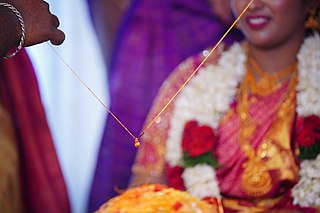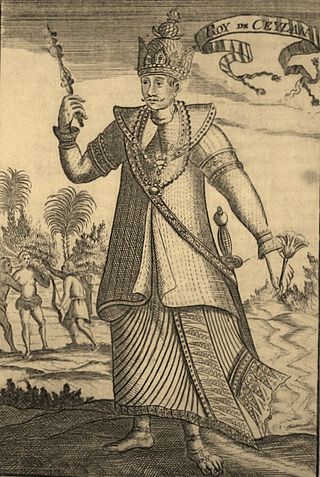
Jewellery consists of decorative items worn for personal adornment such as brooches, rings, necklaces, earrings, pendants, bracelets, and cufflinks. Jewellery may be attached to the body or the clothes. From a western perspective, the term is restricted to durable ornaments, excluding flowers for example. For many centuries metal such as gold often combined with gemstones, has been the normal material for jewellery, but other materials such as glass, shells and other plant materials may be used.

The Kandyan Wars refers generally to the period of warfare between the British colonial forces and the Kingdom of Kandy, on the island of what is now Sri Lanka, between 1796 and 1818. More specifically it is used to describe the expeditionary campaigns of the British Army in the Kingdom of Kandy in 1803 and 1815.

A mangala sutra, or tali, is a necklace that the groom ties around the bride's neck in the Indian subcontinent, in a ceremony called the Mangalya Dharanam during a Hindu wedding. The necklace serves as a visual marker of status as a married Hindu woman.

King Rajasinghe II, also known as Rajasingha II, was a Sinhalese King, reigned 1629 – 6 December 1687; seventh king of the Kingdom of Kandy in Sri Lanka. Rajasingha requested aid from the newly formed Dutch East India Company to help expel the Portuguese from the island, which they successfully did in 1656. By this time however it had become clear to the Kandyans that the Dutch not only intended to expel the Portuguese but to replace them as the major colonial power on the island. This transfer of power is also believed to be where the Sinhala idiom / figure of speech “ඉඟුරු දී මිරිස් ගත්තා වාගේ” Inguru di miris gaththa wagay was originated - in reference that the Dutch Rule was much more of a menace to the king and cruel to the people in the island than the Portuguese. From 1645 onwards Rajasingha was engaged in sporadic warfare with his erstwhile allies.
Khada dupatta is the traditional wedding dress of hyderabadi Muslim brides in the Indian subcontinent. It is an elaborate wedding ensemble comprising a kurta (tunic), chooridaar, and a 6-yard dupatta.

In the Kingdom of Kandy in Sri Lanka, the Kings maintained a harem that consisted of a chief queen and one or two secondary queens. In addition to the queens, the harem also included concubines, who were divided into three categories based on their rank. The highest-ranking category was Randoli, which consisted of consorts of royal blood who held the position of chief queen. The second category, Rididoli, consisted of consorts from either noble families of royal lineage or sisters of Randoli. The lowest ranking category was Yakadadoli, who were from the Radala (Elite) castes.
Chinese pre-wedding customs are traditional Chinese rituals prescribed by the Book of Rites, the Book of Etiquette and Ceremonial and the Bai Hu Tong condensed into a series of rituals now known as the 三書六禮. Traditionally speaking, a wedding that incorporates all six rites is considered a daaih chéui.

The Kingdom of Kandy was a monarchy on the island of Sri Lanka, located in the central and eastern portion of the island. It was founded in the late 15th century and endured until the early 19th century.

Vimaladharmasūriya I was a king of Kandy from 1590 to 1604. His reputation was built when he successfully repulsed two major Portuguese offensives on Kandy, the Battle of Danture in 1594 and the Battle of Balana in 1602, in both of which the Portuguese were humiliatingly defeated.

Elizabeth II owned a historic collection of jewels – some as monarch and others as a private individual. They are separate from the gems and jewels of the Royal Collection, and from the coronation and state regalia that make up the Crown Jewels.

Sri Rajadhi Rajasinha was a member of the Madurai royal family and succeeded his brother, Kirti Sri Rajasinha as King of Kandy in 1782. He was known as a poet-king, with at least one poem written from his hand still known.
Attire of Mangalorean Catholics refers to the traditional clothing of the Mangalorean Catholics from the Mangalore Diocese on the southwestern coast of India.

Tamil people have historically been connoisseurs of fine golden jewellery, which has a history predating the Sangam period in the Indian subcontinent. Ancient Tamil literature lists out the different types of jewellery worn by women historically from head to toe. Apart from gold, jewellery was also fashioned out of silver, copper and brass.

Sri Lanka–United Kingdom relations, or British-Sri Lankan relations, are foreign relations between Sri Lanka and the United Kingdom.
The National Museum of Ratnapura is one of the national museums of Sri Lanka. It is located in Ratnapura, Sri Lanka and it was opened on 13 May 1988. The museum building is called “Ehelepola Walauwa”, as it once belonged to Ehelepola Nilame, a courtier of the Kingdom of Kandy, who was the 1st Adigar under the reign King Sri Vikrama Rajasinha, the last king of Sri Lanka, for whom he served as the Disawe of Ratnapura.
Kandyan law is the customary law that originated in the Kingdom of Kandy, which is applicable to Sri Lankans who are Buddhist and from the former provinces of the Kandyan Kingdom before the 1815 Kandyan Convention. It is one of three customary laws which are still in use in Sri Lanka. The other two customary laws are the Thesavalamai and the Muslim law. At present, Kandyan law governs aspects of marriage, adoption, transfer of property, and inheritance, as codified in 1938 in the Kandyan Law Declaration and Amendment Ordinance.

Ivory carving is one of the traditional industries of Sri Lanka. The country's ivory carving industry has a very long history, but its origin is not yet fully understood. During the Kingdom of Kandy, ivory art became very popular and reached at its zenith. These delicate ivory works represent how Sri Lankan craftsmen mastered in this technique.

The Kandyan period covers the history of Sri Lanka from 1597–1815. After the fall of the Kingdom of Kotte, the Kandyan Kingdom was the last Independent monarchy of Sri Lanka. The Kingdom played a major role throughout the history of Sri Lanka. It was founded in 1476. The kingdom located in the central part of Sri Lanka managed to remain independent from both the Portuguese and Dutch rule who controlled coastal parts of Sri Lanka; however, it was colonised by the British in 1815.

Diana, Princess of Wales, owned a collection of jewels both as a member of the British royal family and as a private individual. These were separate from the coronation and state regalia of the crown jewels. Most of her jewels were either presents from foreign royalty, on loan from Queen Elizabeth II, wedding presents, purchased by Diana herself, or heirlooms belonging to the Spencer family.













